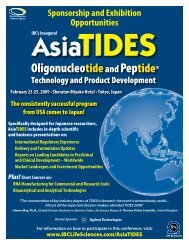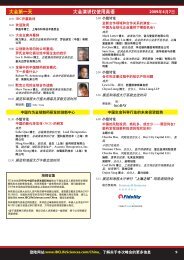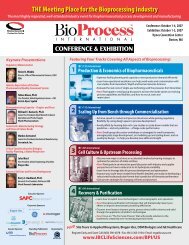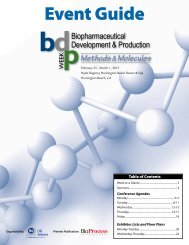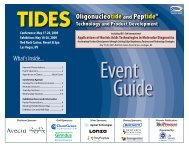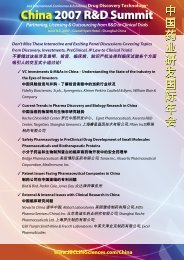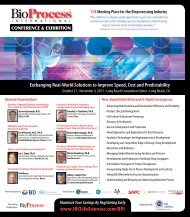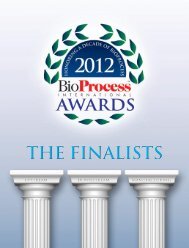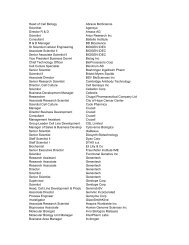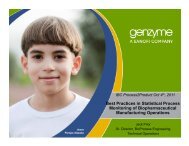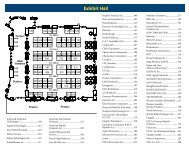Register Early and Save up to $300 (See page ... - IBC Life Sciences
Register Early and Save up to $300 (See page ... - IBC Life Sciences
Register Early and Save up to $300 (See page ... - IBC Life Sciences
You also want an ePaper? Increase the reach of your titles
YUMPU automatically turns print PDFs into web optimized ePapers that Google loves.
Monday, September 20, 2010 • Pre-Conference Symposia<br />
12:00 Registration<br />
Symposium #1: Prevention of Microbial <strong>and</strong> Viral<br />
Contamination of Mammalian Cell Culture Processes<br />
- Lessons Learned <strong>and</strong> Case Studies<br />
1:00 Chairperson’s Remarks<br />
Robert D. Kiss, Ph.D., P.E., Direc<strong>to</strong>r, Late Stage Cell Culture -<br />
Pharma Technical Development, Genentech, Inc.<br />
1:15 How <strong>to</strong> Prevent Microbial Contaminations of<br />
Bioreac<strong>to</strong>rs, <strong>and</strong> Successful Strategies for Addressing<br />
Them if/when They Occur<br />
Andrew Brewer, Senior Engineer, Biologics Manufacturing Science<br />
<strong>and</strong> Technology, Genentech, Inc.<br />
1:45 CSI GMP Production; Lessons from the<br />
Contamination Scene<br />
Katie Stewart, M.S., Technical Training S<strong>up</strong>ervisor, Technical<br />
Training, Human Genome <strong>Sciences</strong> Inc.<br />
2:15 CASE STUDY Microbial Contamination in a CHO<br />
Based Production Culture – A Case Study<br />
Jim McColgan, Associate Direc<strong>to</strong>r, Pilot Lab <strong>and</strong> Production<br />
Operations, Pfizer Global Manufacturing<br />
2:45 Networking Refreshment Break<br />
3:15 Successful Elimination of Parvovirus (MVM) Infections<br />
of Industrial Scale Cell Cultures – Two Case Studies<br />
Tim Hughes, Direc<strong>to</strong>r, Processes & GMP Facilities, CSL Ltd., Australia<br />
3:45 Inactivation of Viruses <strong>and</strong> Mycoplasma by Several<br />
Barrier Methods<br />
Houman Dehghani, Ph.D. Principal Scientist, Biosafety Development<br />
Gro<strong>up</strong>, Amgen Inc.<br />
4:15 Audience Interactive Panel Discussion<br />
5:00 Close of Symposium<br />
Managing Manufacturing Networks<br />
Symposium #2:<br />
How Much Data is Enough The Statistical Approach<br />
<strong>to</strong> Process Validation<br />
1:00 Chairpersons’ Remarks<br />
Ali M. Afnan, Ph.D., Principal, Step Change Pharma, Inc.;<br />
Former Senior Staff Fellow, OPS, CDER, US FDA<br />
1:05 Statistical Assurance of Process Knowledge <strong>and</strong><br />
Control: The Means <strong>to</strong> a Validated Process<br />
Ali M. Afnan, Ph.D., Principal, Step Change Pharma, Inc.;<br />
Former Senior Staff Fellow, OPS, CDER, US FDA<br />
1:50 Elements of a Quality by Design Approach for<br />
Biopharmaceutical Drug Substance Bioprocesses<br />
Nathan McKnight, Ph.D., Senior Engineer, Late Stage Cell Culture,<br />
Genentech, Inc.<br />
2:35 Networking Refreshment Break<br />
3:00 New, Unpublished Data<br />
CASE STUDY Process Underst<strong>and</strong>ing: How do<br />
We Demonstrate that We Know What We Know<br />
Carl A. Anderson, Ph.D., Associate Professor of Pharmaceutical<br />
<strong>Sciences</strong>, Duquesne University<br />
3:45 Strategies for Multi-Variate Studies of Critical<br />
Process Parameters<br />
Ronald D. Snee, Ph.D., Founder <strong>and</strong> President, Snee Associates<br />
4:30 Audience Interactive Panel Discussion<br />
5:00 Close of Symposium<br />
Tuesday, September 21, 2010 • Main Conference<br />
7:00 Registration <strong>and</strong> Coffee<br />
Product <strong>Life</strong>cycle Management<br />
Symposium #3:<br />
Technology Transfer for Biopharmaceuticals<br />
1:00 Chairperson’s Remarks<br />
Jean Bender, Ph.D., Principal Engineer, Genentech, Inc.<br />
1:15 Technology Transfer from Development <strong>to</strong> Manufacturing<br />
John Knigh<strong>to</strong>n, MBA, Direc<strong>to</strong>r, Pharmaceutical Development<br />
& Manufacturing <strong>Sciences</strong>, Johnson & Johnson Pharmaceutical<br />
Research & Development<br />
1:45 Technology Transfer <strong>and</strong> Scale-<strong>up</strong> of an<br />
Antibody Process<br />
Magnus Glad, Ph.D., Senior Project Manager, Biopharmacy & Protein<br />
Technology, BioInvent International, Sweden<br />
2:15 Technology Transfers: Internal versus External,<br />
Domestic versus International<br />
Younok Dumortier Shin, Ph.D., Technical Lead, Manufacturing<br />
Technology, Bris<strong>to</strong>l-Myers Squibb<br />
2:45 Networking Refreshment Break<br />
3:15 Applying Principles of Operational Excellence in<br />
Managing Technology Transfer Projects<br />
Greg Zarick, M.S., PMP, Associate Direc<strong>to</strong>r of Project Management,<br />
Lonza Biologics, Inc.<br />
Michael J. Gorman, M.S., Certified Lean Six Sigma Black Belt <strong>and</strong><br />
Project Manager, Operational Excellence, Lonza Biologics, Inc.<br />
3:45 Integration of Quality Risk Management in<strong>to</strong><br />
Technology Transfer<br />
Lori Richter, Quality Risk Management Associate, Global Quality Risk<br />
Management, Genentech, Inc.<br />
4:15 Audience Interactive Panel Discussion<br />
5:00 Close of Symposium<br />
Advancements <strong>and</strong> Case Studies of<br />
Hydroxyapatite for Biomanufacturing<br />
Leveraging our Assets – How Do We<br />
Reconcile the Installed Base with<br />
Current Technologies <strong>and</strong> Dem<strong>and</strong><br />
7:55 Chairperson’s Remarks<br />
Shishir Gadam, Ph.D., Direc<strong>to</strong>r, Manufacturing Science <strong>and</strong><br />
Technology, Genentech, Inc.<br />
Keynote Presentation<br />
8:05 Optimizing Manufacturing Network<br />
Performance <strong>and</strong> Planning for the Future<br />
Biologics manufacturing network performance can <br />
be measured across many dimensions including cost,<br />
compliance, cycle time etc. It has been useful <strong>to</strong> consider<br />
both plant <strong>and</strong> network parameters <strong>to</strong> optimize current state<br />
performance. These parameters in addition <strong>to</strong> considerations of likely<br />
business, technology <strong>and</strong> socioeconomic changes help shape our<br />
thoughts for future biologics manufacturing.<br />
Alison Moore, Ph.D., Vice President, Corporate Manufacturing,<br />
Amgen<br />
8:45 New, Unpublished Data<br />
CASE STUDY Manufacturing Aspects of a New<br />
Facility: Lessons Learned<br />
Shakedown, qualification, <strong>and</strong> start-<strong>up</strong> of new biotech<br />
manufacturing facilities is a challenging undertaking. Balancing<br />
cost, schedule <strong>and</strong> resources is always a challenge. This talk will<br />
review the lessons learned from the design, commissioning,<br />
qualification, shakedown, <strong>and</strong> validation of numerous large scale<br />
biotech manufacturing facilities, including process equipment <strong>and</strong><br />
au<strong>to</strong>mation lessons learned.<br />
Jeff Johnson, Engineering Direc<strong>to</strong>r, BioVaccine Process Engineering,<br />
Global Engineering Services, Merck & Co., Inc.<br />
9:15 Building the First Patient Specific Product<br />
Manufacturing Plants: Design <strong>and</strong> Construction<br />
of Dendreon Corporation’s Innovative<br />
Manufacturing Facilities<br />
Abstract not available at press date. Please visit<br />
www.<strong>IBC</strong><strong>Life</strong><strong>Sciences</strong>.com/BPI for program <strong>up</strong>dates.<br />
Ken Hammer, Vice President, Facilities <strong>and</strong> Engineering,<br />
Dendreon Corporation<br />
9:45 Networking Refreshment Break<br />
10:15 New, Unpublished Data<br />
CASE STUDY Enabling High Throughput Production<br />
in an Existing Commercial Plant<br />
Lowering cost of goods is achievable by producing product at higher<br />
run rates in an existing facility. This case study presentation focuses<br />
on evaluation of his<strong>to</strong>rical performance <strong>to</strong> identify <strong>and</strong> implement<br />
equipment <strong>and</strong> operational modifications <strong>to</strong> enable manufacture<br />
of product at high run rates. The presentation will report on actual<br />
performance after modifications were implemented. Implications for<br />
design of future processes will also be discussed.<br />
Carol D. Basey, Senior Manufacturing Technical Specialist,<br />
Genentech, Inc.<br />
Process Design: Establishing Design<br />
Space <strong>and</strong> Robust Process Parameters<br />
8:00 Chairperson’s Remarks<br />
Duncan Low, Ph.D., Scientific Executive Direc<strong>to</strong>r, Process<br />
Development, Amgen, Inc.<br />
8:15 CASE STUDY Developing an Appropriate Design<br />
Space Strategy <strong>to</strong> Mitigate Variability in Downstream<br />
Processing Operations<br />
Lot <strong>to</strong> lot variability in chroma<strong>to</strong>graphy adsorbent properties can<br />
result in unacceptable performance. The column operating conditions<br />
may need <strong>to</strong> be designed <strong>to</strong> be adsorbent lot specific <strong>to</strong> achieve<br />
acceptable performance. In this presentation, we discuss how a<br />
design space strategy can be used <strong>to</strong> mitigate such risks, by providing<br />
additional flexibility in applying the appropriate column operating<br />
conditions. Several case studies will be presented.<br />
Justin McCue, Ph.D., Principal Engineer, Downstream Process<br />
Development, Biogen Idec<br />
8:45 Multivariate Data Analyses <strong>and</strong> Real-time<br />
Multivariate Process Moni<strong>to</strong>ring of Upstream<br />
Operations in Biopharmaceutical Manufacturing<br />
Biopharmaceutical processes generate large amount of data in<br />
commercial operations that require advanced modeling <strong>and</strong><br />
moni<strong>to</strong>ring. Multivariate technology allows quickly identifying<br />
patterns in the process data <strong>to</strong> help facilitate process learning<br />
<strong>and</strong> troubleshooting. Examples from large-scale manufacturing<br />
applications in cell culture process moni<strong>to</strong>ring approaches by using<br />
real-time process s<strong>up</strong>ervision will be demonstrated.<br />
Cenk Undey, Ph.D., Senior Principal Engineer, Amgen Inc<br />
9:15 CASE STUDY Creating a QbD Chroma<strong>to</strong>graphy<br />
Design Space Using Mechanistic Modeling Techniques<br />
The FDA has called QbD “a good scientific approach” which involves<br />
“using good science” which “will result in cost benefits for the<br />
industry”. This case study applies mechanistic modeling <strong>to</strong> identify<br />
critical parameters <strong>and</strong> define an ICH/FDA Q8 compliant QbD<br />
design space. Simulations were used <strong>to</strong> improve the separation,<br />
reduce operating costs <strong>and</strong> troubleshoot separation anomalies.<br />
Peter K. Watler, Ph.D., Chief Technology Officer,<br />
Hyde Engineering + Consulting Inc.<br />
9:45 Networking Refreshment Break<br />
10:15 New, Unpublished Data<br />
CASE STUDY Use of DOE <strong>to</strong> Determine Process<br />
Parameters for a Robust Design Space in the<br />
Formulation of a Biopharmaceutical Product<br />
Design of experiments (DOE) <strong>to</strong>ols in product <strong>and</strong> process<br />
development can be confusing <strong>and</strong> frustrating, resulting in<br />
missed opportunities for increased knowledge about the product<br />
or process under consideration. This presentation will outline<br />
general DOE concepts for fac<strong>to</strong>rial <strong>and</strong> fractional fac<strong>to</strong>rial<br />
DOE’s <strong>and</strong> describe a DOE used <strong>to</strong> optimize the formulation of a<br />
biopharmaceutical product.<br />
Martin Kane, Associate Direc<strong>to</strong>r Process Statistics, Department of<br />
Biostatistics, Human Genome <strong>Sciences</strong>, Inc.<br />
“This conference is invaluable for the quality of ideas<br />
exchanged by the participants.”<br />
– David Kolwyck, Technical Manager, SAFC, a division of Sigma Aldrich<br />
Sponsored by:<br />
8:00 am-12:00 pm<br />
We are pleased <strong>to</strong> bring you a half-day technology workshop featuring<br />
many of the world's leading authorities <strong>to</strong> discuss new advancements<br />
<strong>and</strong> applications in separation science using hydroxyapatite <strong>and</strong> related<br />
materials. In this session, we will discuss modern techniques for separation<br />
<strong>and</strong> analysis of immunoglobulins, enzymes, <strong>and</strong> related biomolecules from<br />
micropreparative <strong>to</strong> industrial scale. Speakers will present case studies<br />
<strong>and</strong> the latest developments using hydroxyapatite in the manufacturing of<br />
biopharmaceuticals. A roundtable discussion will conclude this workshop<br />
highlighting key biomanufacturing <strong>to</strong>pics <strong>and</strong> challenges <strong>to</strong>day.<br />
Topics & Presenters:<br />
Dissociation of Antibody: DNA Complexes<br />
by Hydroxyapatite<br />
Pete Gagnon, Chief Scientific Officer, Validated Biosystems<br />
Packing Ceramic Fluoroapatite at Multiple Process Scales<br />
Jaclyn Shaffer, R&D Associate II, MedImmune<br />
Methodology for Extension of Ceramic Hydroxyapatite<br />
Column <strong>Life</strong>time<br />
Mark A. Snyder, Ph.D., Process R&D Applications Manager,<br />
Bio-Rad Labora<strong>to</strong>ries<br />
Ceramic Hydroxyapatite Usage in Process Manufacturing<br />
Norbert Schuelke, Ph.D., Associate Direc<strong>to</strong>r, Millennium<br />
Pharmaceuticals, Inc.<br />
Best Practices for Packing Ceramic Hydroxyapatite at<br />
Process Scale<br />
Kim Brisack, M.S., Staff Scientist, Bio-Rad Labora<strong>to</strong>ries<br />
Key industry leaders <strong>to</strong> present additional case studies<br />
Roundtable Discussion<br />
• Downstream process of monoclonal antibodies<br />
• Scale-<strong>up</strong> <strong>and</strong> optimization of hydroxyapatite, h<strong>and</strong>ling <strong>and</strong><br />
qualification testing<br />
• Chemical robustness of ceramic hydroxyapatite<br />
• Application of hydroxyapatite in vaccine production<br />
Visit www.<strong>IBC</strong><strong>Life</strong><strong>Sciences</strong>.com/BPI<br />
for complete session details<br />
5 To <strong>Register</strong>, Call: (800) 390-4078 • Fax: (941) 365-0104 • E-mail: reg@ibcusa.com





